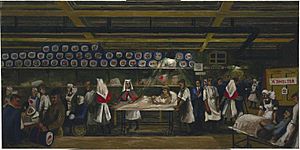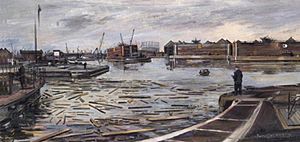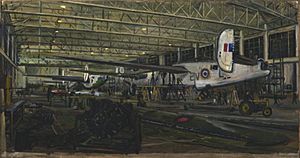Frances Macdonald (English artist) facts for kids
Quick facts for kids
Frances Macdonald
|
|
|---|---|
| Born | 12 April 1914 Wallasey, Cheshire
|
| Died | 5 March 2002 (aged 87) Aberdeen
|
| Nationality | British |
| Education |
|
| Known for | Painting, drawing |
Frances Macdonald (born April 12, 1914 – died March 5, 2002) was an English painter. She was famous for her wide, sweeping paintings of places like Wales, the south of France, and London during World War II.
Contents
Growing Up and Becoming an Artist
Frances Macdonald was born in Wallasey, Cheshire. She was the younger of two daughters. Her father, Francis Macdonald, was a bank manager.
Frances loved art from a young age. She studied at the Wallasey School of Art from 1930 to 1934. After that, she went to the famous Royal College of Art until 1938. While she was there, she met another artist named Leonard Appelbee, who later became her husband.
Painting During World War II
When World War II began, Frances wanted to help as a nurse. But she got a big surprise! She was asked to be a war artist. This was a special job given to artists to record what was happening during the war. It was amazing because she had only just finished art school.
Throughout the war, Frances got many short jobs and special requests to paint pictures. These came from groups like the War Artists' Advisory Committee (WAAC). This meant she could keep working as an artist during the difficult times of the war.
What Did War Artists Paint?
Frances was asked to paint different kinds of scenes. Sometimes she painted nursing scenes, which were often given to women artists. Other times, she painted busy factories and repair work.
Her first painting for the WAAC showed people in a bomb shelter during an air raid. But it was not accepted because it showed too much fear. A second hospital painting was accepted later. She also painted a new version of the Millbank air raid scene, which was accepted in November 1941.
When a hospital moved to Oxford, Frances followed. She was allowed to paint at a nearby aircraft dump. This led to three paintings, though one was not accepted.
Challenges for War Artists
Sometimes, paintings by Frances were accepted but could not be shown to the public. This was because of wartime rules. For example, if a painting showed new buildings or structures built after 1939, it might be kept secret.
In September 1941, she returned to London to paint the city. One of her paintings showed St Paul's Cathedral surrounded by bombed streets. This painting was shown in America during the war. Sadly, it was lost when the ship bringing it back to Britain was sunk.
Later, Frances painted things like the London Docks, aircraft repair shops, and Bailey bridges. She even painted a picture of the person who invented the Bailey bridge, Donald Bailey.
The WAAC bought 19 of Frances's artworks. One important painting, Building the Mulberry Harbour, London Docks (1944), was even asked for by the Tate museum for its permanent collection. The Imperial War Museum also has many of her works.
Life After the War
After the war, Frances had her first solo art show in 1947 at the Wildenstein Gallery. She also created watercolors for a book called Londoner's England in 1947. She wrote and drew for another book, Flowers of Cities, in 1949. Before the Festival of Britain in 1951, she made drawings of the South Bank area of London.
In 1951, the Arts Council asked Frances to paint a large landscape for an exhibition. This was part of the Festival of Britain celebrations. Frances painted a picture of Penrhyn Quarry called The Welsh Singer. Her husband, Leonard Appelbee, also contributed a painting to the same show.
Frances also taught art to students. She taught at Goldsmiths College of Art from 1946 to 1948. She also taught a weekly class at Beckenham and at other art schools like the Byan Shaw School and the Ruskin School of Drawing.
In 1989, Frances and Leonard moved to Scotland to be closer to their only daughter, Jane. Leonard passed away in 2000, and Frances died two years later in 2002.




